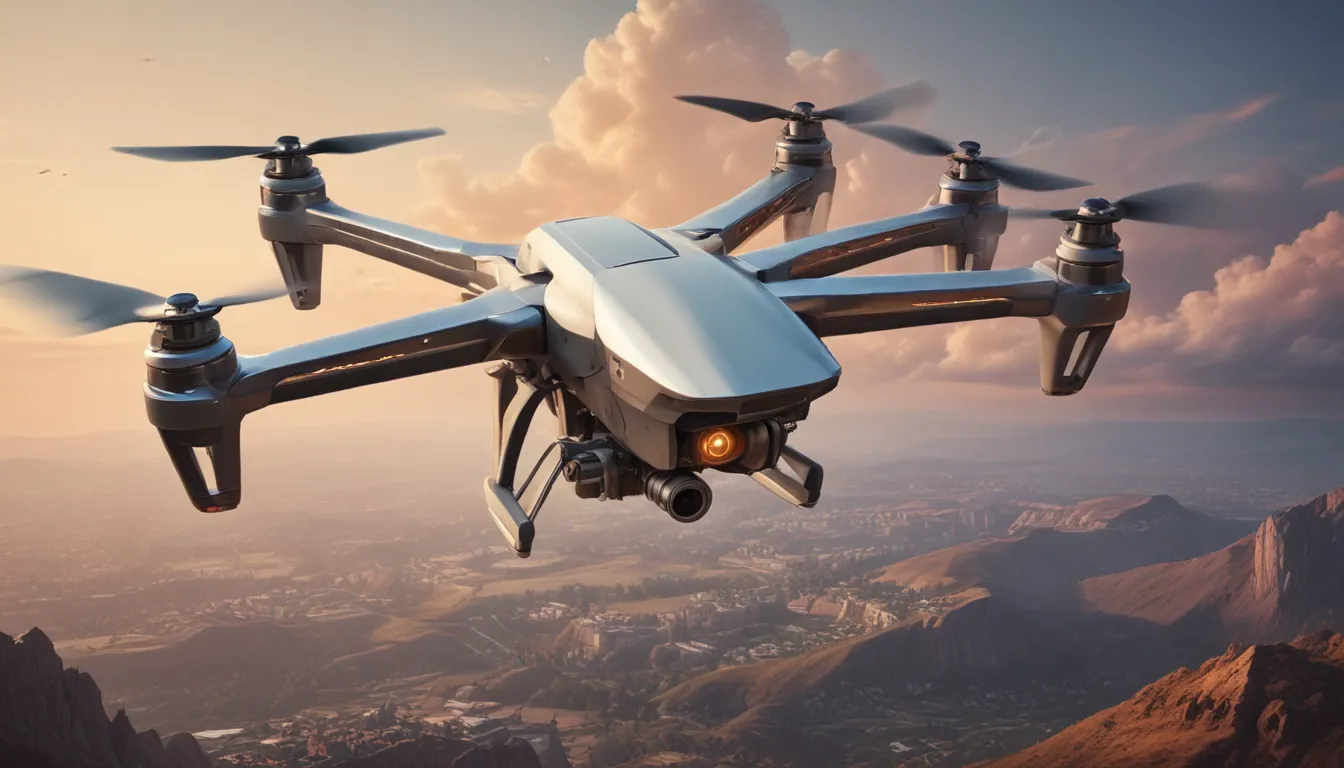A Note About Images: The images used in our articles are for illustration purposes only and may not exactly match the content. They are meant to engage readers, but the text should be relied upon for accurate information.
Welcome to the exciting world of drones, where technology meets innovation to bring endless possibilities. Drones, also known as unmanned aerial vehicles (UAVs), have captured the imaginations of enthusiasts globally, revolutionizing various industries along the way. Join us on a fascinating journey as we delve into the origins of drones, explore their capabilities, and uncover captivating fun facts that make them truly remarkable. Let’s soar through the skies of knowledge and discover the impact of drones on our lives.
The Fascinating History of Drones
The concept of unmanned aerial vehicles dates back to the mid-19th century when Austrians used balloons filled with explosives for military purposes. These early experiments paved the way for the development of modern drones, shaping their evolution into the versatile and advanced technology we know today.
Evolution in Military Applications
Throughout the 20th century, drones underwent significant advancements driven by military applications. The United States played a pivotal role in developing and deploying drones for reconnaissance and combat purposes, showcasing the vast potential of these aerial vehicles in warfare.
Expanding Horizons: From Military to Commercial Use
In recent years, drones have transcended their military origins and made their mark in various industries. From photography and videography to delivery services and recreational activities, drones have found diverse applications, enriching different sectors with their unique capabilities.
Enhancing Agriculture with Precision
One of the groundbreaking applications of drones is in precision agriculture. Farmers now use drones to monitor crops, analyze vegetation health, and apply targeted treatments with remarkable precision and efficiency, revolutionizing traditional farming practices.
Saving Lives with Search and Rescue Operations
Equipped with thermal cameras and advanced imaging systems, drones are instrumental in search and rescue operations. These aerial vehicles provide real-time views, aiding in locating missing persons and assessing disaster-affected areas with unparalleled efficiency.
The Appeal of Quadcopters
Quadcopters, with their four propellers providing stability and maneuverability, have emerged as popular drone configurations. Their versatility makes them suitable for a wide range of applications, from recreational flying to professional use in various industries.
Remote Control vs. Autonomy: The Future of Drones
Drones can be controlled remotely by a human operator using a controller or smartphone. Advanced models boast autonomous capabilities, allowing them to perform pre-programmed tasks and follow predefined flight paths with precision and ease.
Navigating Obstacles with Ease
Many drones now come equipped with obstacle detection and avoidance systems, utilizing sensors and cameras to detect objects in their path. This technology enables drones to adjust their trajectory accordingly, ensuring safe and obstacle-free flights.
Immersive FPV Flying Experience
First Person View (FPV) flying allows drone pilots to experience flights from a first-person perspective. By using virtual reality (VR) goggles or monitors, pilots can see through the drone’s onboard camera in real time, enhancing the thrill of aerial exploration.
Harnessing Technology: GPS and Advanced Sensors
Drones are equipped with GPS systems and a range of sensors, including accelerometers, gyroscopes, and obstacle avoidance sensors. These technologies enable precise navigation, stability in flight, and effective collision avoidance, ensuring safe and efficient drone operations.
The Thrill of Drone Racing
Drone racing has emerged as an exhilarating and rapidly growing sport. Pilots showcase their skills by navigating drones through challenging courses, pushing the limits of speed and agility in thrilling competitions that captivate audiences worldwide.
Mesmerizing Drone Light Shows
Drones are not just tools; they are also artists of the sky. By synchronizing their movements and lights, drones create mesmerizing light shows, forming intricate patterns and displays in the night sky that captivate and inspire audiences around the world.
Record-Breaking Drone Swarm
In a spectacular display of technology and creativity, Intel set a Guinness World Record in 2018 by flying a swarm of 2,018 drones simultaneously. This synchronized flight created a dazzling light show, showcasing the immense potential of drone-swarming technology.
Revolutionizing Logistics: Drone Delivery Services
Companies like Amazon and Google are at the forefront of exploring drone delivery services. By leveraging drones for package delivery, these companies aim to revolutionize the logistics industry, offering quick and efficient delivery services, particularly in remote or challenging-to-access areas.
Aerial Photography and Videography Redefined
Drones equipped with high-quality cameras have transformed the fields of photography and videography. These aerial vehicles enable photographers and filmmakers to capture breathtaking shots from unique perspectives, previously only attainable with expensive equipment or helicopters.
Conservation Efforts Supported by Drones
Drones have become invaluable tools in environmental conservation efforts. From wildlife monitoring to surveying inaccessible areas and detecting environmental changes, drones play a crucial role in supporting conservation initiatives and preserving our planet’s natural resources.
Navigating Regulations: FAA Guidelines
In the United States, drone operations are regulated by the Federal Aviation Administration (FAA). Pilots must adhere to specific guidelines, including registration requirements, airspace restrictions, and operational limitations to ensure safe and responsible drone use.
Respecting Limits: No-Fly Zones for Drones
Certain areas, such as airports, military installations, and national parks, are designated as no-fly zones for drones. It is essential for drone pilots to respect these restrictions to uphold safety, compliance with regulations, and responsible drone operation.
Prioritizing Safety: Responsible Flying Practices
Drone pilots play a crucial role in ensuring safe and responsible drone operations. By following best practices such as maintaining a visual line of sight, avoiding crowded areas, respecting privacy, and operating within their skill level, pilots contribute to a culture of safety and accountability in the drone community.
Embracing the Future of Drone Technology
Drones have revolutionized our perspective of the world, offering endless opportunities and applications across diverse industries. From aerial photography to delivery services, drones continue to inspire us with their capabilities, promising a future where the sky’s the limit for innovation and exploration. As technology advances and regulations evolve, drones will undoubtedly play an increasingly significant role in shaping our lives and industries. Embrace the marvels of drone technology, and witness the transformative power of these incredible flying machines.
Frequently Asked Questions (FAQs)
Are drones legal to fly anywhere?
Drone regulations vary by country, so it’s essential to familiarize yourself with local laws and restrictions before flying in a specific area to ensure compliance and responsible drone operation.
How long can drones fly on a single battery charge?
Flight times for drones depend on various factors such as model, battery capacity, payload, and flight conditions. Generally, consumer drones offer flight times ranging from 10 to 30 minutes on a single charge.
Can drones be used for package delivery?
Companies like Amazon and DHL are exploring the potential of drones for package delivery. However, regulatory and logistical challenges need to be addressed before widespread adoption can occur.
Can drones be used for agricultural purposes?
Absolutely! Drones equipped with specialized sensors and cameras are valuable tools for crop monitoring, pest detection, and precision agriculture, enhancing farming practices and improving crop yields.
Do drones raise privacy concerns?
Drones have raised privacy concerns due to their ability to capture images and videos from the air. Laws and regulations are in place to ensure responsible and ethical drone use, respecting privacy rights and safeguarding personal information.
As you embark on your journey through the world of drones, remember to prioritize safety, respect regulations, and embrace the endless possibilities that these remarkable aerial vehicles offer. Join us in celebrating the marvels of drone technology and witness firsthand the transformative impact of these incredible flying machines.






